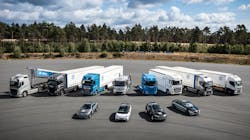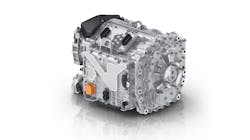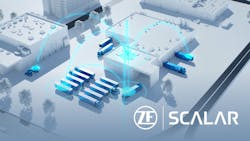ZF advances automated, electric technologies for commercial vehicles
Six months after the launch of its new Commercial Vehicle Solutions (CVS) division, the focus at ZF Friedrichshafen AG is clear: automation, electrification, and connectivity are driving the company’s product development roadmap.
ZF unveiled a selection of commercial vehicle technology advances at its testing facility in Jeversen, Germany, ahead of the IAA Transportation conference in September. The new developments—not yet available in the market—come on the heels of ZF’s acquisition and integration of Wabco. The acquisition helped set up ZF as the largest supplier to the commercial vehicle industry, ZF Group CEO Wolf-Henning Scheider said.
See also: ZF showcases safety solutions at TMC
“Our commercial vehicle range now accounts for 18% of total group sales, with an internationally reinforced presence in the United States, India, and China,” Scheider said during a July 19 press conference for the company’s annual Global Technology Day.
“Our commercial vehicle business is also benefitting from the economy of scale,” he added. “For us, it’s quite clear at ZF that the future of mobility will be electric for cars and trucks.”
To further enhance its "Next Generation Mobility" strategy, ZF highlighted the company’s ability to transfer technologies across vehicle segments in automation and electric drivetrains for passenger and cargo freight transport.
Next-gen eMobility for commercial vehicles
Alluding to ZF’s cross-divisional approach, ZF board member Wilhelm Rehm, who is responsible for the new CVS Division, said the integration of Wabco is already paying off, as CVS combines the advantages of a regionalized organizational structure with those of the global group.
“The trend towards automated, connected, and electrified vehicles represents a huge commitment in development costs for OEMs,” Rehm stated. “With our wide range of integrated solutions, ZF offers customers the opportunity to be at the forefront of technology while reducing their development efforts.”
During the press event, ZF premiered its CeTrax 2 integrated, modular electric driveline for heavy-duty commercial vehicles. The new system combines what ZF calls a “favorable” power-to-weight ratio and a “highly integrated, compact design."
The driveline features a sustained output of 360 kW and improved efficiency through powershift gear changes, ZF stated. It also features technologies, including a hairpin design for the stator, a cooling system, and a silicon carbide-based inverter, all adapted from ZF’s passenger car technology. Series production with a global vehicle manufacturer will start next year, the company noted.
Demonstrating the success of its software development, ZF also premiered Scalar, a new digital solutions platform that enables transport-as-a-service capabilities for commercial vehicle fleets. A fully automated planning, routing, and dispatching solution, ZF Scalar combines and connects technologies on board commercial vehicles and third-party systems with artificial intelligence.
Underlining its advance from components manufacturing to integrated automation solutions, ZF also unveiled how it is leveraging its Scalar Orchestration platform and its next-generation Autonomous Driving Open Platform Technology (ADOPT) 2.0 automated chassis control solution for end-to-end yard automation. ADOPT 2.0 focuses on low-speed yard automation applications up to 12.4 mph. In addition, ZF will also showcase ADOPT 3.0, which enables hub-to-hub highway applications at speeds up to nearly 50 mph.
“Our order books already show that despite a challenging environment, the need is there for modern technology as a solution to the immense challenges of the industry,” Rehm said. “To meet these challenges, there is no need for more of everything but for intelligent solutions that are destined to contribute to fewer emissions and safety.”
In addition, Scheider noted that ZF is working with legislators in Europe, the U.S., China, Brazil, and other countries to prove that these technologies are safe.
“We are successful when we can prove that these products contribute to the safety of people,” he said. “We have already been successful in convincing legislators to change legislation based on these new modern technologies so they can be introduced to the market. For this technology in North America, I am very optimistic that there will not be any obstacles posed by legislation for introducing the technology.”
Electric steer-by-wire automation
During its global technology event, ZF premiered its advanced steer-by-wire technology for the front axle. This technology transmits driver commands to the steering system entirely through electrical signals, removing the mechanical link between the steering wheel and front axle. Going forward, by-wire technology is expected to play a pivotal role in all aspects of vehicle motion control, according to ZF.
The current technology is for use in passenger vehicles; however, ZF’s new steer-by-wire technology will also be applied to commercial vehicle automation, Scheider added. The company also announced that this technology will be launched on an industrial scale by a “major global automaker within the next year.”
By-wire systems offer greater degrees of vehicle control, creating shorter stopping distances, more degrees of freedom in maneuvering, better stability at high speeds, and greater range and efficiency, ZF pointed out. With by-wire technologies, the amount of steering assist or brake torque can be tuned to mimic the typical feel that drivers expect. It can also be instantly adjusted to enhance brake force to reduce stopping distances or steer around an obstacle, the company noted.
Further, ZF’s brake-by-wire IBC braking system enables regenerative braking and energy recuperation that helps recharge electric vehicle batteries.
When it comes to bringing all these technologies to market, Scheider acknowledged that semiconductor shortages still present a challenge.
“It’s going to keep us all busy for a longer period,” he said of the component shortages. “The whole industry is suffering from this. There is an overproportion of growth and demand for semiconductors—that’s clear in the market. Everyone is sourcing these globally, so in the next five years, they are expected to ramp up in demand.”
“Camera systems, by-wire systems, and everything that controls electronics requires these components and will be a topic on the agenda for a long time, Scheider added. Our portfolio is very versatile. We can’t supply the full portfolio range yet, but it has tremendously improved. We at least think we have a good strategy to approach it.”
This article originally appeared on FleetOwner.com.


